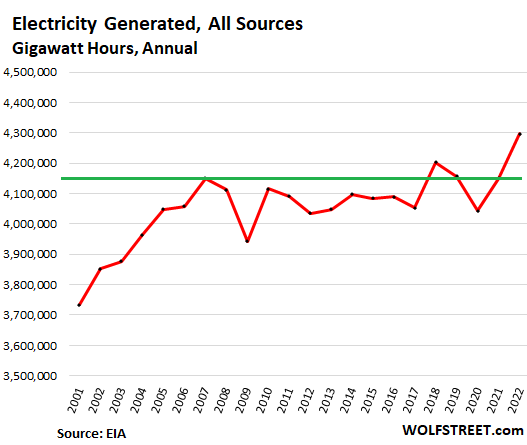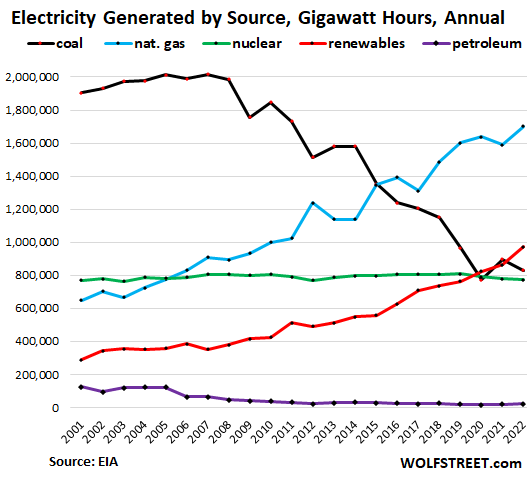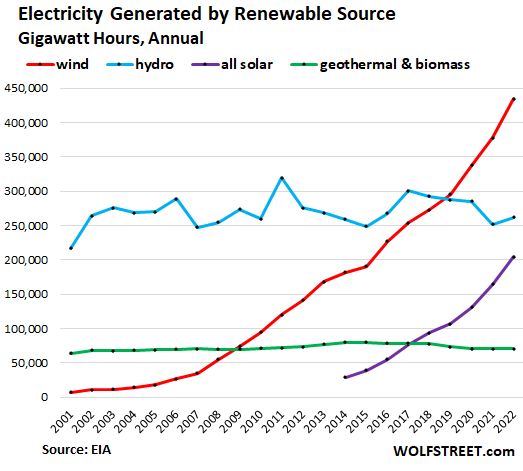
By Wolf Richter for WOLF STREET.
Electricity generation, as measured in gigawatt-hours, has gotten hammered by a near-stagnation in demand since 2007, as efforts to make everything more efficient have produced results for electricity users who’d invested in more efficient lights, appliances, electronic equipment, industrial equipment, heating and air-conditioning, etc. and in better building insulation, shading, etc. These upfront costs by electricity users produced financial returns via reduced electricity consumption. For electric utilities, it meant that they were stuck in a demand quagmire.
But then in 2022, there was finally the breakout in demand after 14 years. EV charging and crypto mining come to mind. And electricity generation rose by 3.5% from 2021, to a new record of 4,297,000 gigawatt-hours, according to EIA data released today. But 2021 had been flat with 2007, and so in 2022, the amount of electricity generated was only up by 3.5% from 2007!
The chart shows the total amount of electricity generated each year by utility-scale power plants and by small-scale solar installations, such as rooftop solar. The green line connects 2021 and 2007:

The share of total electricity generated by source:
- Share of natural gas and other gases rose to a record high of 39.6%
- Share of coal dropped to a record low of 19.3%, down from 51% in 2001
- Share of nuclear: 18.0%
- Share of all renewables (wind, hydro, solar, geothermal, biomass): 22.6%
- Share of renewables without hydro: 16.5%
- Share of wind: 10.1%
- Share of hydropower: 6.1%
- Share of solar, including rooftop: 4.8%
- Share of geothermal and biomass: 1.6%
- Share of petroleum liquids and coke: 0.5%.
The mix of how electricity was generated changed dramatically over the years.
The chart below shows the amount of electricity generated by source since 2001. For this chart, I combined wind, hydro, solar, geothermal, and biomass into the “renewables” category. In a moment, we’ll get to these categories separately:

The combined share of electricity generated by wind and solar, including small-scale solar, rose to 14.9%. The share has doubled in the six years since 2016.
Small-scale solar accounted for 1.4% of total power generated in the US in 2022 and for 29% of total solar. In gigawatt hours, generation has increased by 430% since 2014, the first year that the EIA started tracking it, going from 11,000 gigawatt hours in 2014 to 58,500 gigawatt hours in 2022.
Biomass includes several small categories: wood and wood-derived fuels (36,600 gigawatt hours), landfill gas (9,000 gigawatt hours), other waste biomass (2,200 gigawatt hours).
Most geothermal plants are in California, built in the 1970s (17,000 gigawatt hours).

The decline of coal: Technological innovation, fracking, wind.
The decline of coal – from a share of 51% in 2001 to 19% in 2022 – was driven by several forces:
- Technological innovation: The combined-cycle natural-gas power plant became commercially available in the 1990s. In this type of plant, natural gas drives a gas turbine (similar to a jet engine) that drives a generator. In addition, the exhaust heat is used to create high-pressure steam that powers a steam turbine that also drives a generator. They have a thermal efficiency of around 65%. In other words, about 35% gets lost as waste heat, compared to a coal plant where over 60% is lost as waste heat. The natural gas combined-cycle power plant is hard to beat on a cost basis.
- Cheap natural gas from fracking: the boom in fracking for natural gas in the US caused the price of natural gas to plunge by 2009. The price of US natural gas is extremely volatile. For example, after the brief spike early last year, the price plunged late last year and returned to being dirt cheap.
- Wind power plants are now more cost efficient than coal plants – both have installation costs, but the wind is free, and coal is not, over the life of the plant.
Coal power plants cannot compete with a combined-cycle natural gas plant and with wind power, and no new coal-fired power plants have been built over the past decade.
Planned power-plant retirements & additions in 2023.
Retirements: 14.5 GW in total. The oldest and least efficient coal-fired plants – most of them built in the 1970s and 1980s – are being retired on an ongoing basis. In 2022, coal power plants with a capacity of 11.5 gigawatts were retired; in 2023, coal power plants with a capacity of 8.9 GW are scheduled to be retired, according to the EIA.
In addition, older natural gas plants with 6.2 GW of generating capacity will be retired in 2023; for a total retirement (coal and natural gas combined) of 14.5 GW.
Additions: 56.1 GW in total of new utility-scale electric-generating capacity is scheduled to be added to the power grid in 2023, the most since 2002, according to the EIA, for a net gain in capacity of 41.6 GW, the largest gains since 2003.
Of the 56.1 GW in capacity additions in 2023:
- Solar: 29 GW
- Natural gas: 7.8 GW
- Wind: 7.5 GW
- Nuclear: 2.2 GM (the two reactors at Vogtle plant in Georgia).
- Battery storage: 9.5 GW, more than doubling the existing capacity of 8.8 GW! About three-quarters of the additions will be in Texas and California.
Battery storage isn’t a power generator per se, of course. But given its function of selling electricity when demand and prices are high (after buying when they’re low), it’s for now classified as power generation capacity. Maybe when it grows up, it will have its own category.
Battery storage has turned into a hot arbitrage opportunity, where storage facilities can buy electricity on the wholesale market when it’s cheap during times of the day with excess capacity, and sell it during the hours of peak pricing. Batteries help balance out loads and and work well in conjunction with wind and solar installations. They’re now turning into a big business opportunity.
WOLF STREET publishes a new article? Sign up here.
ENB Top News
ENB
Energy Dashboard
ENB Podcast
ENB Substack



